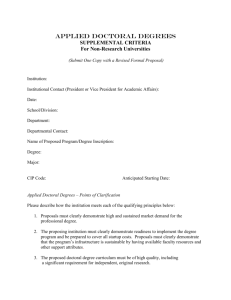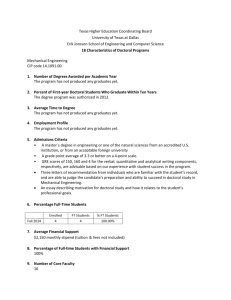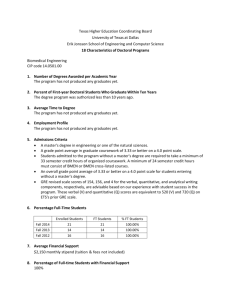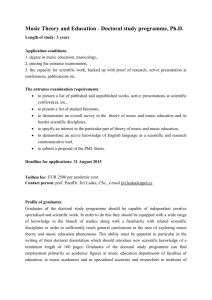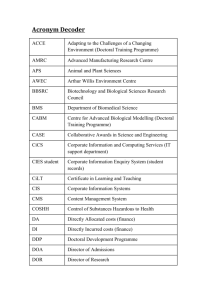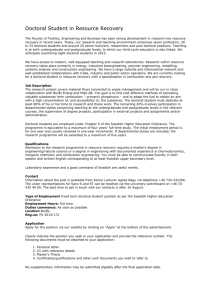Format for Preliminary Authority Requests
advertisement
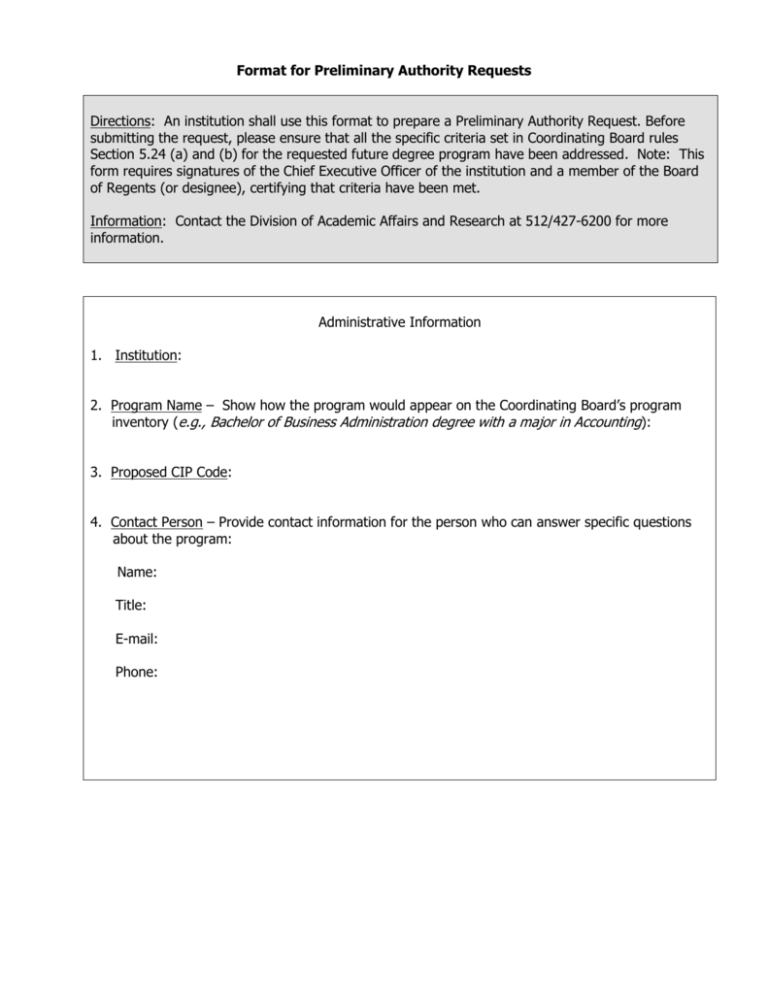
Format for Preliminary Authority Requests Directions: An institution shall use this format to prepare a Preliminary Authority Request. Before submitting the request, please ensure that all the specific criteria set in Coordinating Board rules Section 5.24 (a) and (b) for the requested future degree program have been addressed. Note: This form requires signatures of the Chief Executive Officer of the institution and a member of the Board of Regents (or designee), certifying that criteria have been met. Information: Contact the Division of Academic Affairs and Research at 512/427-6200 for more information. Administrative Information 1. Institution: 2. Program Name – Show how the program would appear on the Coordinating Board’s program inventory (e.g., Bachelor of Business Administration degree with a major in Accounting): 3. Proposed CIP Code: 4. Contact Person – Provide contact information for the person who can answer specific questions about the program: Name: Title: E-mail: Phone: Program Information 1. Program Description Briefly describe the requested future degree program (or programs if requesting broad authority). 2. Criteria For each program, address the following criteria that the Coordinating Board considers when granting preliminary authority requests. A. Required for all requests (bachelor’s, master’s, and doctoral programs): 1. A demonstrated need for a future program in terms of present and future vocational needs of the state and the nation. Instructions: Provide short- and long-term evidence of the need for graduates in the job market. Common sources for workforce need and workforce projections include the Bureau of Labor Statistics, Texas Workforce Commission, and professional associations. For programs that do not lead directly into a job, describe how the proposed program would enhance opportunities currently unavailable to students, prepare students for graduate education, etc. 2. Whether the proposed addition would complement and strengthen existing programs at the institution. Instructions: Describe the existing resources that would be leveraged and/or strengthen with the proposed program. For example, a proposed bachelor’s degree in computer engineering could potentially complement and strengthen an existing program in electrical engineering. 3. Whether a future program would unnecessarily duplicate other programs within the region, state, or nation. Instructions: Identify similar programs and explain how the future program would not unnecessarily duplicate them. Provide evidence that existing programs could not accommodate additional students and/or are not meeting current workforce need. NOTE: CB Rule 5.42(2): “The offering of basic liberal arts and science courses and degree programs in public senior institutions is not considered unnecessary duplication.” 4. Whether a critical mass of students and faculty is likely to be available to allow the program to be offered at a high level of quality and to become self-sufficient on the basis of state funding. Instructions: Provide evidence of student demand for the program. Types of data commonly used include increased enrollment in related programs at the institution, high enrollment in similar programs at other institutions, qualified applicants rejected at similar programs in the state or nation, and student surveys. Provide evidence that an adequate number of high-quality faculty would be available. In addition, provide evidence that projected enrollment would enable the program to become financially self-sufficient on the basis of state formula funding and revenues from tuition and fees. B. Additional information required for requests for doctoral programs: 1. A demonstrated regional, state, or national unmet need for doctoral graduates in the field, or an unmet need for a doctoral program with a unique approach to the field. Instructions: Provide short- and long-term evidence of the unmet need for individuals trained at the doctoral level. Common sources of workforce need and workforce projections include the Bureau of Labor Statistics, Texas Workforce Commission (primarily for professional doctorates), and professional associations. Provide evidence that existing programs across in the country could not accommodate additional students and that the number of graduates is not meeting workforce need and/or is not projected to meet future workforce need. 2. Evidence that existing doctoral programs in the state cannot accommodate additional students (or that accessibility to these programs is restricted), or that expanding existing programs is not feasible or would not best serve the state. Instructions: Provide evidence that existing doctoral programs in the state could not accommodate additional students and that the number of graduates is not meeting workforce need and/or is not projected to meet future workforce need. 3. If appropriate to the discipline, the institution has self-sustaining baccalaureate and master’s level programs in the field and/or programs in related and supporting areas. Instructions: Provide evidence that existing undergraduate and master’s programs within the same 2-digit CIP code as the program requested have sufficient enrollments to sustain themselves and that they are regularly producing graduates. 4. The program has the potential to obtain state or national prominence and the institution has the demonstrated capacity, or is uniquely suited, to offer the program and achieve that targeted prominence. Instructions: Describe in detail any resources that would enable the proposed doctoral program to attain state or national prominence. Some indicators of the potential to attain state or national prominence would be the presence of established, renowned scholars; well-equipped facilities; and other unique features of the institution or the proposed program (e.g., its proximity to certain resources). 5. Demonstrated current excellence of the institution’s existing undergraduate and graduate degree programs and how this excellence shall be maintained with the development and addition of a high-quality doctoral program. Measures of excellence include the number of graduates and graduation rates that match or exceed those of peer institutions. Instructions: Provide evidence of institution-wide excellence. Measures of institution-wide excellence include, but are not limited to, the number of graduates and graduation rates that match or exceed those at peer institutions. In addition, provide evidence that existing doctoral programs at the institution are regularly producing graduates and that doctoral programs approved within the last five years are making satisfactory progress. 6. Satisfactory placement rates for graduates of the institution’s current doctoral programs, with comparison to peer group placement rates when available. Instructions: Provide the placement rates of recent graduates into jobs that are closely related to the disciplines. 7. How the program will address the goals of Closing the Gaps by 2015. Instructions: If applicable, demonstrate (1) how the proposed doctoral program would strengthen undergraduate participation, especially among underrepresented groups in Texas; (2) how the proposed program would improve undergraduate success, especially among underrepresented groups in Texas; (3) how the proposed program would help the state achieve its excellence goals, with particular emphasis on excellence in undergraduate education; and (4) how the proposed program would capitalize on and enhance research activities, as well as help the state achieve its goals of increasing federal and private research expenditures, if applicable to the discipline. 8. Institutional resources to develop and sustain a high-quality program. Instructions: Describe the institutional commitment to building resources in faculty, facilities, library holdings, and other areas critical to the success of a high-quality doctoral program. 9. Where applicable, a demonstration of plans for external accreditation, licensing, or other applicable professional recognition of the program. Instructions: If applicable, describe plans for obtaining external programmatic accreditation and a timeline for doing so. Signature Page For a preliminary authority request to be approved by the Coordinating Board, the Chief Executive Officer of the institution and the Board of Regents (or designee) must certify that the new program meets the criteria under TAC Chapter 5, Subchapter B, Section 5.24. I certify that the new program meets the criteria specified under TAC Section 5.24. _______________________________________________________________ Chief Executive Officer of Institution Date ______________________________________ Board of Regents (Designee) _______________________ Date
